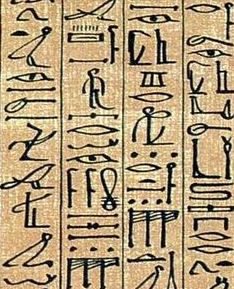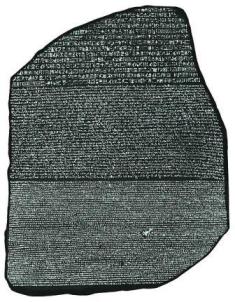🌎 Ancient Egypt: Achievements-Writing
- Due Sep 30, 2024 by 11:59pm
- Points 10
- Submitting a file upload
- Available Sep 30, 2024 at 12am - Oct 7, 2024 at 11:59pm
Watch these video Links to an external site.
video Links to an external site.
video Links to an external site.
and this video Links to an external site.
Rosetta Stone Video Links to an external site.
sounds chart Links to an external site.
Learning Objective
I will learn how writing developed and was used in Ancient Egypt.
 Assignment Instructions
Assignment Instructions
How did writing develop in Ancient Egypt?
Read the information below.
Hieroglyphics
The Ancient Egyptians used picture words to write in what is called hieroglyphics, a word that means "sacred carvings" in Greek. It is a very old form of writing that the Egyptians started using as early as 3000 B.C. Hieroglyphics was a very complicated way of writing involving 1000s of pictures of people, animals, plants, and objects. Some of the symbols represented sounds, like our letters, and others represented entire words.

Hieroglyphics was different from how we write in many ways:
- It could be written in almost any direction; left to right, right to left, or top to bottom. The reader would figure out which way to read it by the direction of the symbols.
- It didn't use any punctuation.
- It did not use vowels between consonants.
- It was written to look beautiful and look like art.
- A single picture symbol could stand for a whole word, called an ideogram, or a sound, called a phonogram. For example, a picture of an eye could mean the word "eye" or the letter "I".
Cartouches
Cartouches are oval frames which surround the hieroglyphs that make up the name of an Egyptian God or royal person. The frame was drawn with a looped rope which was believed to have magical powers to protect the name written inside. Cartouches were supposed to protect the person in this life and in the afterlife. They were arranged both vertically and horizontally depending on the symbols used.
Scribes
Since writing in hieroglyphics was so complicated, it took years of education and practice to be able to do it. The people who trained to write were called scribes. They recorded important events, and wrote legal documents, religious texts, letters, and bills. They wrote on stone and papyrus. Scribes enjoyed a high status in Egyptian society since very few people learned to read or write. They did not have to pay taxes or enter the army. Only children of the wealthy got the opportunity to train as scribes. They would start training at a very young age of six or seven.
Papyrus
The Ancient Egyptians often wrote on tablets or walls, but they also wrote on a type of paper called papyrus. Papyrus paper was made from a tall reed like plant called papyrus. Papyrus grows best in the still shallows of marshlands. It is a tall plant growing three to twelve feet along the banks of the Nile. Papyrus was used in many ways such as in sandals, baskets, ropes, and sails. The lower part could even be eaten when roasted. It was also used to create paper. The Egyptians would use strips of the inner stem of the plant to make the paper. They would make two layers of strips; one horizontal and the other vertical. Then they would cover it in a linen cloth and apply pressure with a mallet or stones. The strips would bind together over time making a single flat sheet to write on. Several sheets might be glued or sewn together to make a scroll. The longest known scroll is more than one-and-a-half times the length of a basketball court. Papyrus remained basically the same for four thousand years until paper, which originated in China, replaced it after the eighth century A.D.
Rosetta Stone

For more than a thousand years, the ability to read and write hieroglyphic script was lost. In 1799 a French soldier found a special stone in the city of Rosetta in the Nile Delta. The stone was divided into three sections of writing, each written in a different script. The bottom section was written in Greek, a language still read and spoken. Assuming that the three sections had the same message, the Greek was used by Jean-Francois Champollion to eventually translate the hieroglyphics in the top section. This translation was then used to figure out hieroglyphics written in many other places and on many other artifacts helping us to begin to understand Egyptian life and culture.
Information adapted from:
Nelson, Ken. (2020). Ancient Egyptian History for Kids: Hieroglyphics. Ducksters. Retrieved from https://www.ducksters.com/history/ancient_egyptian_hieroglyphics.php Links to an external site.
Give it a try!
Use the image below to create your own cartouche or write a message in hieroglyphs! Remember, not every sound in English will translate perfectly so just do your best to get as close as possible. Submit a picture or video of your work.
 Guidelines
Guidelines
Work should show accuracy and effort.
 Find Rubric
Find Rubric
